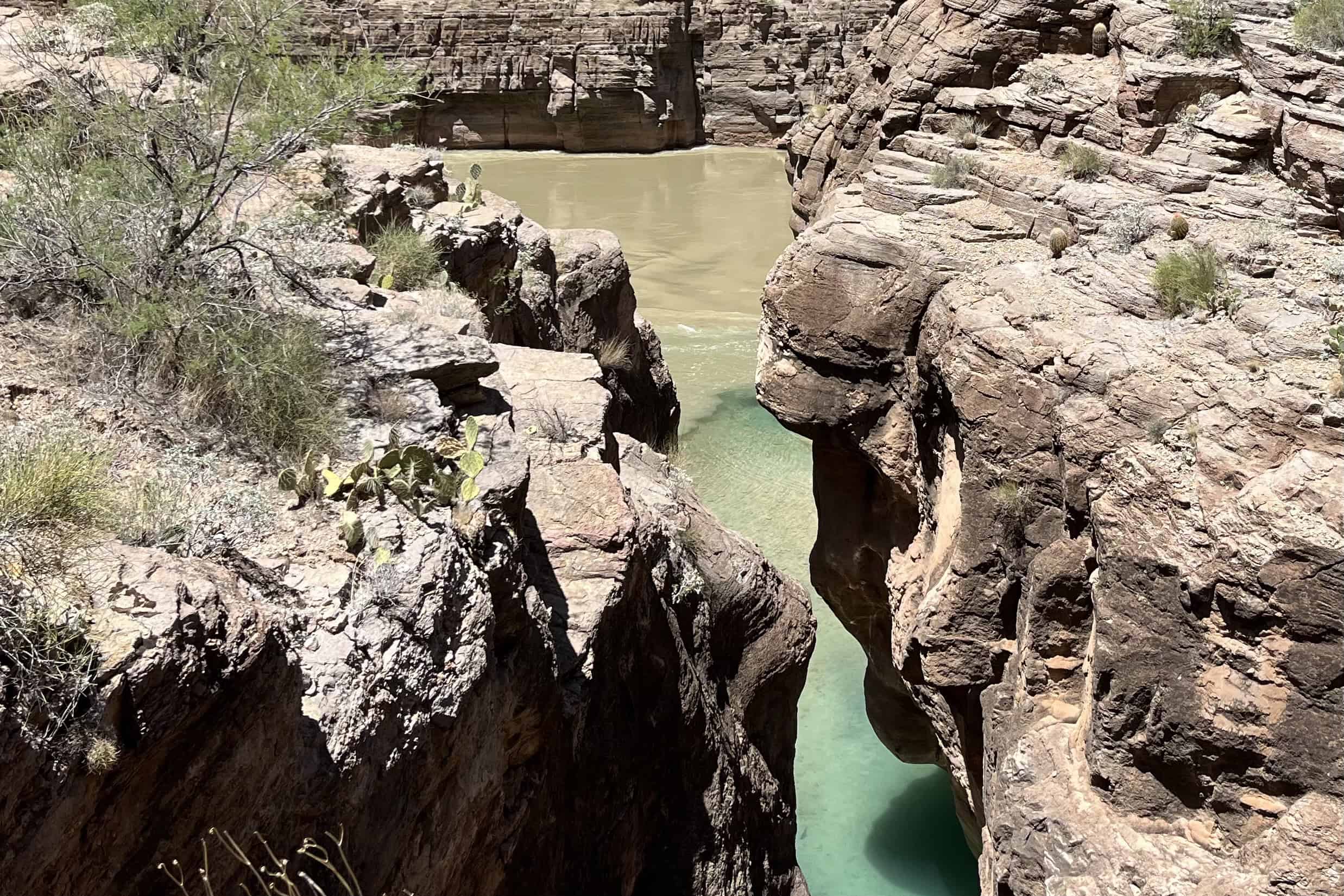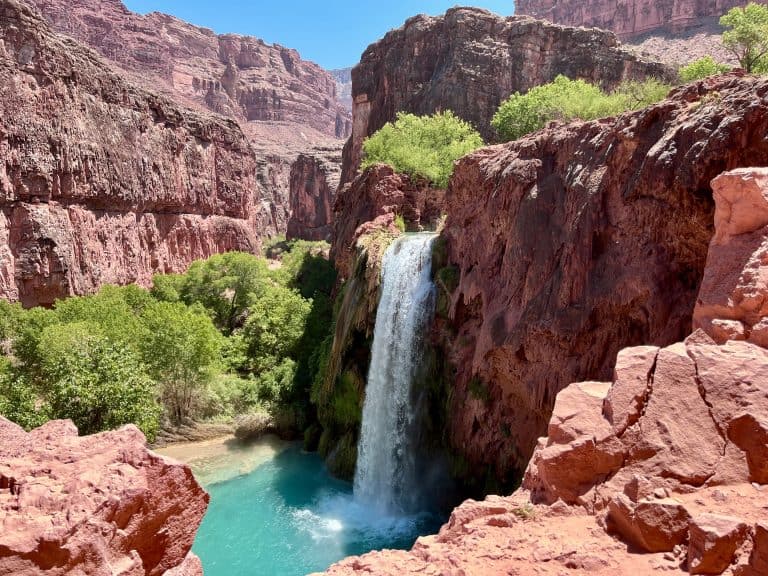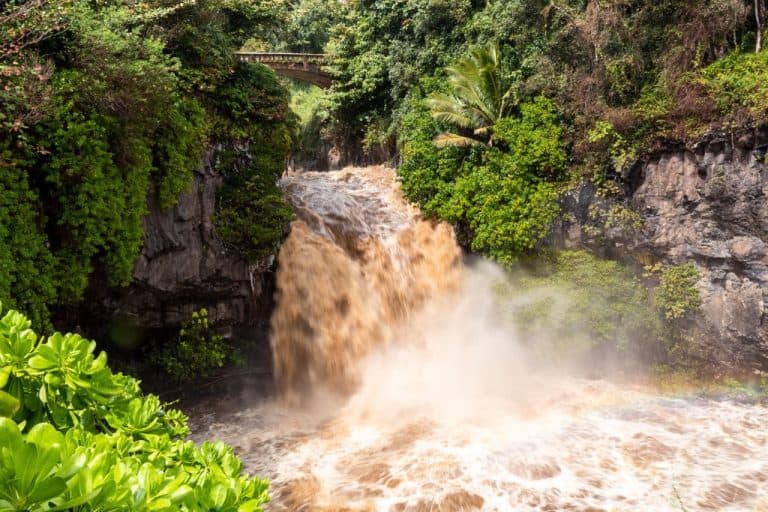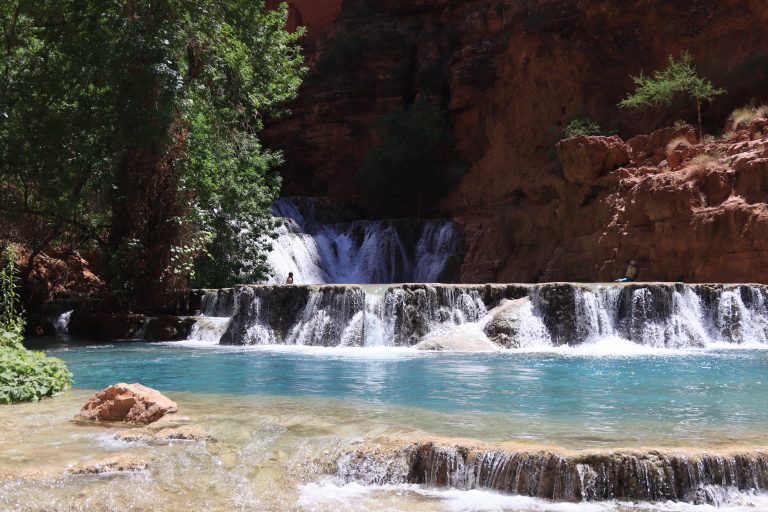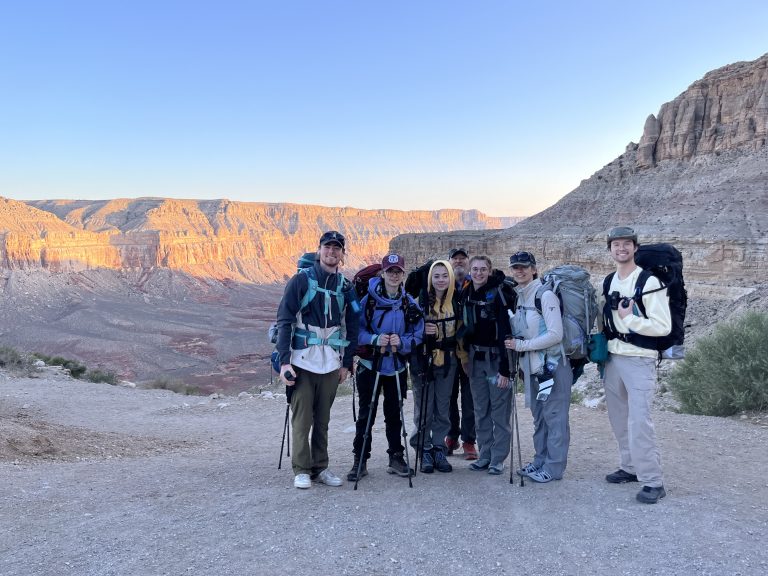Where Havasu Creek Meets the Colorado River
The Havasupai Confluence is not for everyone — and that’s what makes it special. So who should actually take the challenge?
When planning our trip to Havasupai, the biggest question mark was whether or not we would do the Confluence. First we said no. Then we said yes. Then we said maybe.
I read countless posts trying to determine if it was right for us. Some said it was the best part of the whole trip; others said it was overrated and not really worth it. With only four days to experience everything Havasupai has to offer, I was completely conflicted whether to dedicate an entire day to this daunting and slightly overwhelming hike.
If you’re in that same place — debating, researching, flip-flopping — this is the guide I wish I’d had. Here’s what makes the Confluence unique, and how to know if it’s the right choice for your trip.
This post contains affiliate links, meaning if you purchase them after clicking on my link, I may earn a small commission. I only recommend items that I personally use and love or that I think will add value to your trip. Thank you for supporting my blog.
What Is the Havasupai Confluence?
The Havasupai Confluence is where the turquoise waters of Havasu Creek meet the muddy, sediment-rich Colorado River deep in the Grand Canyon. It’s a little surreal: two rivers flowing side by side, but never fully blending- a sharp contrast of colour and energy.
But it is more than a meeting of rivers; it is a powerful metaphor. For anyone who has ever stood before a larger, overwhelming force and struggled to maintain their identity without being consumed, the Confluence speaks. The vibrant turquoise of Havasu Creek holds its own as it merges, but does not blend, with the mighty Colorado River. Distinct. Set apart. Resilient.
It is a visual reminder that we can stand with strength, individuality, and integrity even in the wake of seemingly more powerful forces.
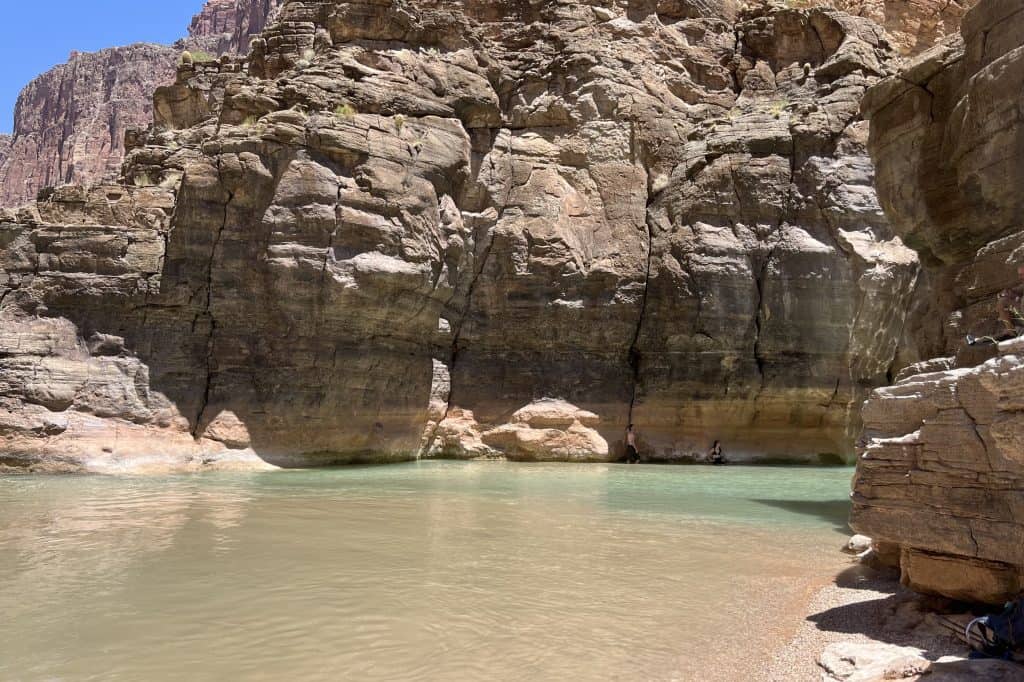
It’s a place that can move you — not just for its beauty, but for what it represents. But while the Confluence may speak to the soul, reaching it requires strength from the body. The trail is long, remote, and challenging. So before setting out, ask yourself: is this hike right for you?
Related Read: 👉🏻 Havasupai Trail Complete Guide: Permits, Tips & Highlights
Is the Confluence Worth It — and Who Should Hike It?
These are the questions I wanted answered before setting out on the Confluence. I had read that it depended on the type of trip you wanted and the type of person you are. But nobody told me what that meant.
So this is everything I wanted to know about who should hike the Confluence before I went.
You’ll want to do the Confluence if:
- You are an experienced, avid hiker that loves to push your personal limits.
- You find long, challenging hikes with beautiful views rewarding and fulfilling.
- You have the endurance and stamina for a long, technical day hike – AllTrails clocked us at 18.5 miles (30 km) from the top of Mooney Falls and back.
- You didn’t hike 10 miles into Havasupai to stop short- you want to see absolutely everything the canyon has to offer.
- You’re ok trading time spent soaking in the falls for time spent exploring deeper in the backcountry.
- You want to get off the beaten track, and explore the trails less travelled.
You might want to skip it if:
- Your main focus is enjoying the falls and relaxing at camp.
- You’re content with the hike to Beaver Falls and don’t feel the need to push further.
- You’re unsure about your ability to complete a tough day hike — or you’re already fatigued from the journey in and worried it could impact your hike out.
When deciding whether or not to go, be honest with yourself about your goals and your abilities. Half of our group trekked all the way to the Confluence, and half of us stopped at Beaver Falls. For both groups it was the right decision and the right way to spend the day.
📌 Reminder: There is no camping anywhere in Havasupai Tribal Land except the designated campground. This means the entire hike must be completed in one day.
Seasonal Considerations
The time of year you are doing the hike can be an important determining factor also. The Havasu Creek is a consistent 70° F (21° C) year round. We did the trip in late May, which means the water was refreshing and a welcome break from the heat. The sun dried us quickly, so we did not have to spend hours hiking in wet clothes. This was the ideal time for us to tackle the hike, and each season has its own unique considerations.
Early Spring or Late Fall
✅ Pros:
- Cooler Temperatures:
- The canyon can be brutally hot in summer. In spring/fall, daytime highs are usually far more tolerable (often 60s–80s°F / ~15–30°C), which makes a long hike more manageable.
- Less Crowding:
- If you go before or after the peak season (March–early April or late October–November), the trails, campsites, and falls may be significantly quieter.
- Better Conditions for Long Hikes:
- The Confluence is an 18-mile round-trip trek — cooler weather helps conserve energy and reduces the risk of heat exhaustion.
- Less Time for Swimming
- The water stays a cool ~70°F (21°C) year-round, but it can feel much colder in spring/fall, especially if the air is chilly. You might be inclined to spend less time swimming and lounging at the falls, leaving more time to enjoy an extended hike.
⚠️ Cons/Challenges:
- Shorter Daylight Hours:
- In early spring and late fall, you’ll have fewer daylight hours, which increases your risk of returning after dark. You’ll need to start at dawn and bring a headlamp just in case.
- Cold Mornings & Evenings:
- Overnight temps in the canyon can dip into the 30s–40s°F (0–10°C). Be prepared with warm layers for camping and early morning starts.
- Icy or Slippery Conditions at Mooney Falls:
- If it’s still cold in the mornings, chains and ladders at Mooney Falls may be wet, muddy, or even icy — which can make the descent more dangerous. Go slow and wear good grippy shoes.
- Flash Flood Risk (Spring):
- While summer is peak monsoon season, early spring storms or snowmelt upstream can still cause dangerous flash floods in narrow canyon sections.
- Colder River Crossing:
- The cooler temperatures can make the river crossings less enjoyable. Be prepared with moisture wicking and quick drying layers.
Late Spring / Early Fall (May–early June, Sept–early Oct)
✅ Pros:
- Warm but not extreme:
- Daytime highs usually range from 80–95°F (27–35°C) — still hot, but more manageable than midsummer.
- Longer daylight:
- ~12–14 hours of light gives you a generous hiking window to complete the Confluence in a day.
- Enjoyable River Crossings:
- Water temps are comfortable, and it’s hot enough to enjoy the falls.
- Less risk of monsoons:
- These windows fall outside Arizona’s peak monsoon season (which starts in late June/early July), making it a high demand time to visit.
⚠️ Cons/Challenges:
- Hot during the exposed hike:
- You’ll need sun protection and plenty of water, especially for the return hike.
- Crowds:
- These months are very popular, especially May and September, so expect more people on the trail and around the falls.
- Fatigue factor:
- With the heat and long mileage, this is still a demanding day — don’t underestimate it.
Summer (late June–August)
✅ Pros:
- Longest days of the year:
- You’ll have 14+ hours of light to complete the hike.
- Perfect for swimming:
- With high temps, the cold water is refreshing and helps regulate body temperature.
- Lush vegetation:
- Havasu Canyon is green and vibrant, especially around the falls.
⚠️ Cons/Challenges:
- Extreme heat:
- Temps can soar to 100–110°F (38–43°C) — very dangerous for long, exposed hikes.
- High risk of heat exhaustion:
- The Confluence hike involves a lot of sun exposure, elevation change, and scrambling — triple that risk when it’s this hot.
- Monsoon season:
- From late June to early September, sudden afternoon thunderstorms and flash floods are a real danger in the canyon.
- Water logistics:
- You’ll need much more water — at least 4–6 litres per person — and electrolyte supplements.
📌 Pro Tip: No matter what season you go, sun protection (hat, sunscreen, sunglasses, lip balm), a quality lightweight water filter, high energy snacks, and plenty of water with electrolytes are essential.
The Route to the Confluence
The journey from the campground to the Confluence can be divided into two sections:
Campground to Beaver Falls via Mooney Falls
This first stretch is approximately one-third of the total distance to the Confluence and is a stunning hike in its own right.
It begins with the infamous descent down Mooney Falls, where you’ll navigate a steep cliffside using ladders, chains, and narrow tunnels carved into the rock. From the base of Mooney, you’ll follow Havasu Creek downstream for roughly 3.5 miles (5.6 km) one way.
The trail weaves through lush vegetation, crosses the creek several times, and offers gorgeous views of limestone walls and cascading blue water. It’s adventurous, scenic, and popular, and many hikers choose Beaver Falls as their turnaround point.
For full details, including tips for navigating the ladders and creek crossings, check out our guide: Beaver Falls- The Best Day Hike in Havasupai
Beaver Falls to the Confluence
After Beaver Falls, the trail continues for another 5.5 miles (9 km) one way, leaving Havasupai Tribal Land and entering Grand Canyon National Park. The path becomes rougher here — with more frequent rock scrambles, creek crossings, and sections of loose terrain. Keep an eye out for rock cairns, which help guide the way through this less-defined stretch.
As you push deeper into the canyon, the landscape becomes increasingly rugged and remote. Towering red walls rise on either side, evoking the majesty of Zion’s Narrows. The vibrant greenery along the creek bed feels tropical — like something out of Kauai, Hawaii’s lushest island. And the surreal turquoise flow of Havasu Creek is reminiscent of Lake Louise, vivid and almost otherworldly.
It’s as if three natural wonders converge here — Zion’s grandeur, Kauai’s lushness, and Banff’s glacial blues — woven together in one hidden oasis that winds steadily toward the mighty Colorado River.
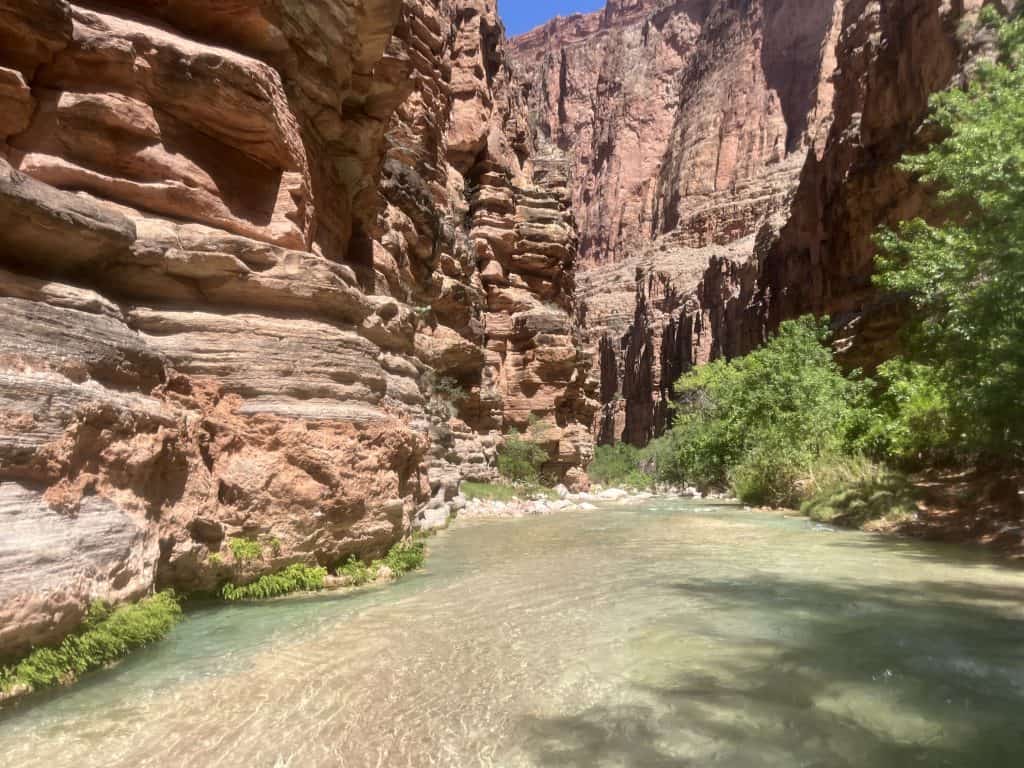
At the Confluence
About half a mile from the end, the trail passes through a short tunnel before descending into a chest-deep river crossing. From here, hikers have two options: scramble up to the top of the canyon wall for sweeping views, or swim through a narrow slot canyon in Havasu Creek that leads directly to the Confluence.
⚠️ Safety Tip: The Colorado River is swift, cold, and powerful. Swimming should be limited to Havasu Creek, well upstream from the point where it meets the Colorado. The junction itself can create unpredictable currents and undertows — even strong swimmers should avoid entering the Colorado.
After cooling off with a refreshing dip in the creek, find a shady spot to enjoy lunch and take a well-earned rest. Soak in the moment — and appreciate what you’ve accomplished. Let the symbolism of this sacred place resonate and appreciate the grandeur of God’s playgrounds. This remote place has the type of simple beauty that can humble you if you listen to it.
📌 Pro Tip: Before you hit the trail, prep a hot lunch and pack it in a high-quality food thermos. After hours of hiking, there’s nothing better than opening your pack to find a warm, ready-to-eat meal waiting for you at the Confluence.
They are lightweight, durable, and keep your food warm for hours.
Once you’ve recharged, it’s time to retrace your steps for the long journey back.
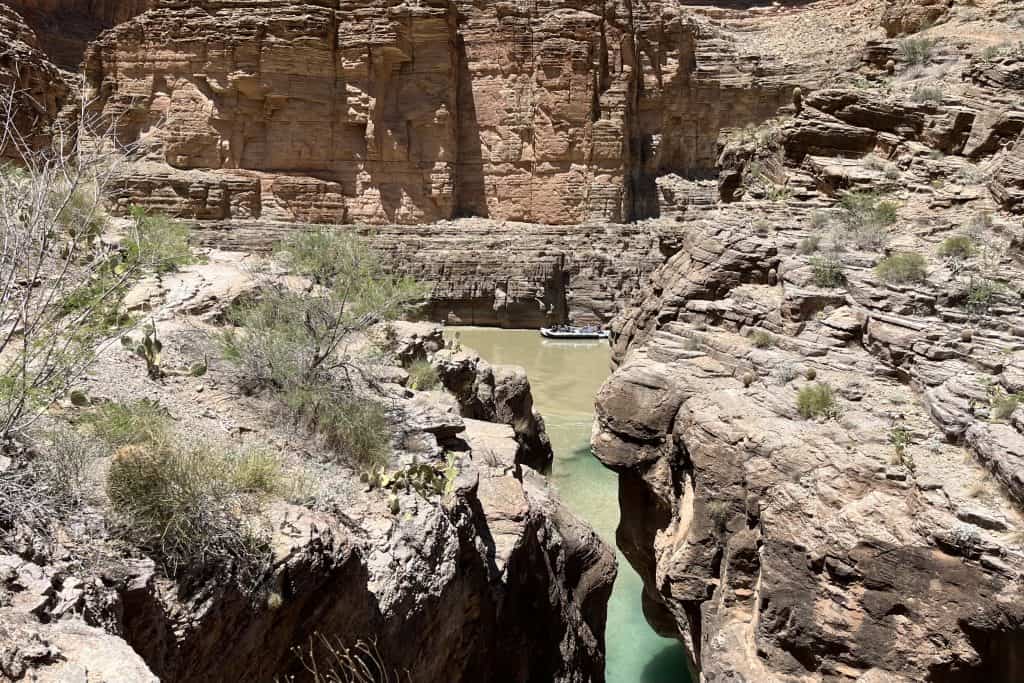
Keep an eye out for wildlife along the trail — it’s part of what makes the journey to the Confluence so special. It’s not uncommon to spot bighorn sheep perched high on the canyon walls, tree frogs hidden among the reeds, songbirdsflitting through the trees, or lizards and butterflies basking in the sun.
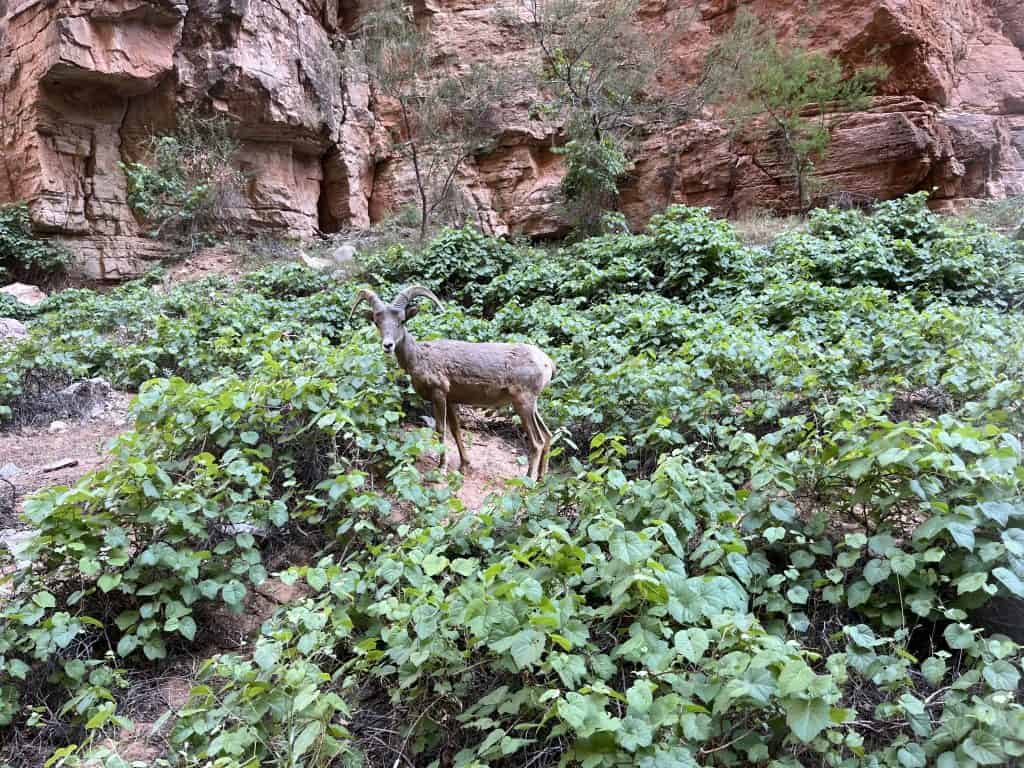
This land doesn’t belong to us — we’re only visitors here. Please treat it with the respect it deserves by following Leave No Trace principles: pack out everything you pack in, stay on the trail, and avoid disturbing wildlife. Leave the canyon better than you found it, so future generations can experience its magic too.
Tips for a Successful Confluence Hike
Start Early
- Plan for 6-10 hours depending on hiking speed and time spent relaxing.
- Larger groups typically need a longer time to account for varied abilities and difficulties along the way.
- If you have a group that moves at different paces, consider long range walkie talkies to keep communication flowing and establish check in points.
Essential Gear
- Prepare for the Heat: Stay Hydrated and Sun Safe
- Sun Protection
- Hydration
Havasu Creek will be your main water source- bring a lightweight water filter to keep your hydration bladder full.- Katadyn BeFree 1.0L with Activated Carbon Filter – Lightweight and fast, perfect for day hikes
👉🏼Buy at: REI | Amazon - Platypus Big Zip Hydration Bladder
👉🏼Buy at: REI | Amazon - Electrolytes help replace what you lose through sweat and can help prevent dehydration, cramps, and fatigue. Always keep some on hand.
- Katadyn BeFree 1.0L with Activated Carbon Filter – Lightweight and fast, perfect for day hikes
- High Energy Snacks
- Jerkey
- Mixed nuts
- Protein bars
- Tuna and chicken packets
- Water Crossings
Some crossings involve balancing on wet logs or rocks, while others require wading directly through the water. The current is usually gentle, but good traction is essential.- I wore Teva Omnium sandals with CoolMax toe socks for the entire hike, which gave me solid grip and no blisters — though I did have to stop a few times to shake out sand.
- Prepare for the Unexpected
It’s like insurance: you hope you don’t need them, but if you do, you’re glad you have it!
Cell Service
- Expect no cell service past Mooney Falls
- The top of Mooney has an inconsistent signal — once you descend, you’ll be completely off-grid.
- Download your AllTrails or offline map beforehand
- This trail isn’t always obvious, especially at river crossings and forks — having a GPS track helps.
- Consider a satellite communicator
Cell service is extremely limited once you enter the canyon. A satellite device allows you to text family, communicate with your group, and reach emergency services if needed.
Havasupai Confluence: Final Thoughts
The hike to the Havasupai Confluence is not easy — it’s long, remote, and demanding. But for those who make the journey, it can be a powerful and unforgettable experience. The beauty of this place isn’t just in the turquoise water or soaring canyon walls — it’s in the silence, the solitude, and the symbolism of two powerful forces meeting without losing themselves.
Whether you’re seeking adventure, challenge, or clarity, the Confluence has something to offer. For us, we felt the pull of the Colorado River even after the hike ended. We launched into a Black Canyon self guided kayak trip less than 48 hours later, where we traded desert trails for emerald waters and let the magic of the Colorado carry us forward.
For you, just be honest about your goals, your limits, and what you want from your time in Havasupai. You don’t have to hike to the end of the canyon to have a meaningful experience — but if you do, the rewards are unlike anything else.
Choose the hike that speaks to you — and either way, you’ll leave with a story worth telling.

